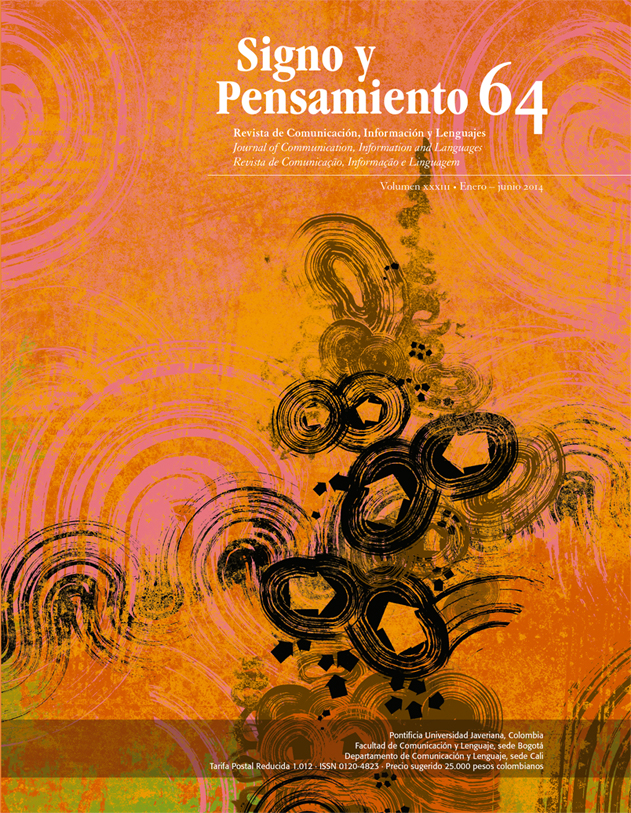Semantic frameworks: a proposal for the analysis of the reconfiguration of meaning in YouTube.
##plugins.themes.bootstrap3.article.details##
YouTube’s main feature is the diversity of content, which supports this website popularity among Internet users. From this idea, the concept of semantic framework is proposed as a case study to analyze the reconfiguration of meaning in that platform. A methodological strategy is developed, taking as an example the videos from Harry Potter’s film franchise. In the case of the hegemonic meanings inscribed in a primary media text, such reconfiguration can be studied in two levels: through the interaction of the promotional videos of the franchise with the amateur videos produced, and by the actual content of the latter. The article concludes that the access of cultural practices associated with fandom, as it is the amateur video production, stresses the urgency to question and discuss the legitimacy of the exacerbated consumption in industrial societies. Key words: YouTube, semantic frameworks, reconfiguration.
YouTube, Semantic frameworks, ReconfigurationYouTube, entramados semánticos, reconfiguración.YouTube, Enredos semânticos, Reconfiguração
Anatol, G. (2003). Reading Harry Potter: Critical essays. Westport, CT: Greenwood.
Barker, C. (2004). The Sage dictionary of cultural studies. Londres: Sage [Formato electrónico].
Benassini, C. (1991). Nuevas perspectivas en el análisis del mensaje televisivo. Comunicación y sociedad, 13, 89-100. Recuperado de http://www.publicaciones.cucsh.udg.mx/pperiod/ comsoc/pdf/13_1991/89-100.pdf
Biltereyst, D., Mathijs, E. y P. Meers. (2008). An avalanche of attention: the prefiguration and reception of The Lord of the Rings. En M. Barker y E. Mathijs (Eds.). Watching The Lord of the Rings (pp. 37-57). Nueva York: Peter Lang Publishing.
Burgess, J. y Green, J. (2011). YouTube: online video and participatory culture. Cambridge: Polity Press.
Cheng, X., Dale, C. y Liu, J. (2008). Statistics and social network of YouTube videos. En Proceedings of the 16th International Workshop on Quality of Service (pp. 229-238). Enschede, Holanda. doi: 10.1109/IWQOS.2008.32
Dirks, T. (2013). Greatest movie series film franchises of all time. Box-Office results (Domestic Gross).Recuperado de AMC filmsite: http:// www.filmsite.org/series-boxoffice.html
Elsaesser, T. (2009). Tales of Epiphany and Entropy: Around the worlds in eighty clicks. En P. Snickars y P. Vonderau (Eds.) The YouTube reader (pp. 166-186). Estocolmo: National Library of Sweden. [Formatoelectrónico].
Fiske, J. (1992). Audiencing: a cultural studies approach to watching television. Poetics, 21, 345-359.
Fiske, J. (1999). Television culture. Londres: Routledge.
García Canclini, N. (1997). Culturas híbridas y estrategias comunicacionales. Estudios sobre las Culturas Contemporáneas, 3(5), 109-128.
Hall, S. (2001/1980). Encoding/decoding. En M. G. Dirham y D. M. Kellner (Eds.). Media and Cultural Studies: Keyworks (pp.166-176). Malden, MA: Blackwell Publishing.
Heilman, E. (Ed.) (2009). Critical perspectives on Harry Potter. Nueva York: Routledge.
Heilman, E. y Donaldson, T. (2009). From sexist to (sort-of) feminist representations of gender in the Harry Potter series. En Heilman, E. E. (Ed.). Critical perspectives on Harry Potter (pp. 139-161). Routledge: New York.
Ibáñez, J. (2002). Perspectivas de la investigación social: el diseño de las tres perspectivas. En M. García, J. Ibáñez y F. Alvira (Comp.). El análisis de la realidad social. Métodos y técnicas de investigación (pp.57-98). Madrid: Alianza Editorial.
IAB México (Interactive Advertising Bureau de México), Millard Brown y Televisa.com. (2013). Estudio de consumo de Medios entre internautas mexicanos. 5ta. Edición. Recuperado de IAB México: http://www.iabmexico. com.mx
Jenkins, H. (1992). Textual Poachers. Television fans & participatory culture. Nueva York: Routledge.
Jensen, K. B. (2005). A handbook of media and communication research: Qualitative and quantitative methodologies. Londres: Routledge.
Krippendorff, K. (1997). Metodología de análisis de contenido. Teoría y práctica. Barcelona: Paidós.
Lang, P. (2007). Commenting on comments: investigating responses to antagonism on YouTube. Documento no publicado presentado en la Society for applied anthropology conference. Tampa, Florida.
Lozano, J. C. (1994). Hacia la reconsideración del análisis de contenido en la investigación de los mensajes comunicacionales. En C. Cervantes y E. Sánchez (Coords.). Investigar la comunicación. Propuestas iberoamericanas (pp.135-357). Guadalajara: Universidad de Guadalajara.
Morris, N. (2002). The myth of unadulterated culture meets the threat of imported media. Media, Culture and Society, 2 (24), 278-289.
Nexon, D. yNeumann I. (2006). Harry Potter and International Relations. Lanham, Maryland: Rowman& Littlefield.
Query, J., Wright, K., Amason, P., Campbell, K., Weathers, M., Womack, M., Gilchrist, E., Bochenek, L. y Pedrami, V,. (2009). Using Quantitative Methods to Conduct Applied Communication Research. En L. Frey y K. Cissna (Eds.). Routledge Handbook of applied communication research (pp. 81-105). Nueva York: Routledge.
Rivera-Perez, L. (1996). Rethinking ideology: polysemy, pleasure and hegemony in Television Culture. Journal of Communication Inquiry, 20 (2), 37-56.
Schrøder, K.C. (2000). Making sense of audience discourses. Towards a multidimensional model of mass media reception. European Journal of Cultural Studies, 3 (2), 233-258. doi: 10.1177/136754940000300205
Snickars, P. y Vonderau, P. (Eds.). (2009).The YouTube reader. Estocolmo: National Library of Sweden. [Formato electrónico].
Solomon, C. (2005, agosto 21). Files share and share alike. The New York Times. Recuperado de http://www.nytimes.com/2005/08/21/arts/ 21solo.html?_r=2
Straubhaar, J. (2007). World Television: From Global to Local. Thousand Oaks: Sage. [Formatoelectrónico].
Uricchio, W. (2009).The future of a medium once known as television. En P. Snickars y P. Vonderau (Eds.) The YouTube reader (pp. 24-39). Estocolmo: National Library of Sweden. [Formato electrónico].
YouTube.(2012, diciembre 6). A new look to help you to subscribe and watch channels on YouTube. Recuperado de Broadcasting ourselves. The official YouTube blog: http:// youtube-global.blogspot.mx/2012/12/a-newlook-to-help-you-to-subscribe-and.html
YouTube. (2013). Statistics. Recuperado del sitio Web YouTube: http://www.youtube.com/t/ press_statistics
YouTube y percy2403. (2007, noviembre 26).Potter Puppet Pals: Harry and Ginny’s wedding! (part one). Recuperado de http://youtu.be/ urRa6MdVGTg


